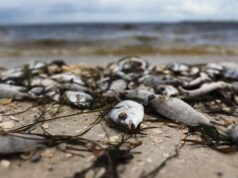
Ten years ago, BP’s Deepwater Horizon oil rig exploded, spilling 200 million gallons of crude into the Gulf of Mexico. It was the worst oil spill in history.
In the months following, emergency responders dumped millions of gallons of chemical dispersants into the Gulf to help clean up the spill, but that didn’t get rid of all the oil—and the chemicals themselves created a whole host of other devastating problems. Dispersants like the ones used in the 2010 BP spill are the subject of a new lawsuit against the federal government.
The University of California Berkeley’s Environmental Law Clinic teamed up with individuals affected by dispersants and environmental nonprofits including the Center for Biological Diversity to sue the Environmental Protection Agency (EPA). They hope to compel the EPA to restrict the use of chemical agents to clean up oil spills.
“Overwhelming scientific evidence indicates that dispersants likely do more environmental harm than good, and generally exacerbate a spill’s ecological impact,” the lawsuit says. “Further, dispersants have significant adverse human health impacts for oil spill responders and coastal residents.”
Some of the suit’s plaintiffs have seen those adverse impacts firsthand. One of them is Kindra Arnesen, a Gulf Coast commercial fisher. In 2010, she lived in Venice, Louisiana, a community devastated by BP’s oil spill and its aftermath.
Arnesen and her family were directly exposed to the chemical dispersant Corexit. She alleges that it gave her rashes, headaches, and chronic pain and fatigue, and that her husband George, who also works in the fishing industry, lost significant body mass and experienced dizziness and frequent ear infections. Their children, Aleena and David, also suffered, experiencing rashes, respiratory problems, migraines, and even fainting spells. Scientific evidence shows Corexit can cause all of these symptoms.
A decade later, the Arnesens are still feeling the health consequences of chemical dispersants. They’ve suffered significant economic losses since they own a commercial fishing business that’s suffered in the aftermath of the spill. The suit alleges that the disperants have caused “deformities, developmental problems, and a decline in the overall fish population” in the fish stocks in the Gulf, cutting in the the Arnesens and other fishing operators’ livelihoods.
Despite overwhelming evidence of the harm they can cause to humans and animals alike, the EPA’s current National Contingency Plan (NCP) around the use of dispersants and other chemicals claims they’re “safe” to use. It hasn’t been updated since 1994, even though the EPA’s own inspector general has said that regulations on dispersants are needed.
“Every coastal state is actually pre-authorized to use these chemicals,” marine toxicologist Riki Ott, another plaintiff, told Earther. Ott saw dispersants used firsthand in response to the Exxon Valdez oil spill in Alaska’s Prince William Sound in 1989. “It’s not just that there’s an allowance, that they’re allowed to be used… there’s an expedited process to use them.”
This isn’t the first time the EPA has faced pressure to create these regulations. In 2012, they received a petition, signed by some of the new case’s plaintiffs, that showed the documented health risks of using dispersants dating back to the Exxon Valdez oil spill in 1989. The EPA proposed new regulations in 2015, but never finalized them. Given the Trump administration’s rampant environmental deregulation bent, it’s unlikely the agency is going to make moves to finalize those regulations anytime soon without pressure being applied.
The National Oceanic and Atmospheric Administration says that dispersants haven’t been used on spills in federal waters since 2010’s Deepwater Horizon disaster. But Ott is sure that they’re still used in state waters.
“Folks around the Gulf of Mexico, around Alaska, they say they see people spraying these dispersants all the time, not necessarily for big spills, but for the little ones that happen every day,” she said. “Because their use is preauthorized, it’s like, ‘who cares?’”
Ott isn’t sure exactly what should be used to clean up oil spills instead of these harmful chemicals, but she knows “the answer is not to do nothing.
“They’re pretty damn hard to clean up, but that’s not an excuse for not developing something other than these dispersants,” she continued. “The oil industry can drill a mile underneath the ocean, the industry wants to drill two miles under ocean—all this technology to get the oil out has leaped and bounded forward. And yet we still have the same toxic dispersants that we had 30 years ago?”
She hopes the suit and new regulations will force industries to come up with better solutions. But the best way to protect people and wildlife from oil spills is not to drill for oil in the first place. And there’s ample evidence that that’s a good move for the planet anyway.
Source: gizmodo.com








